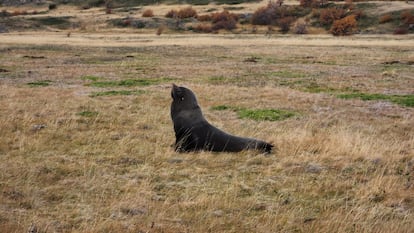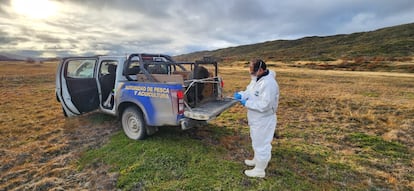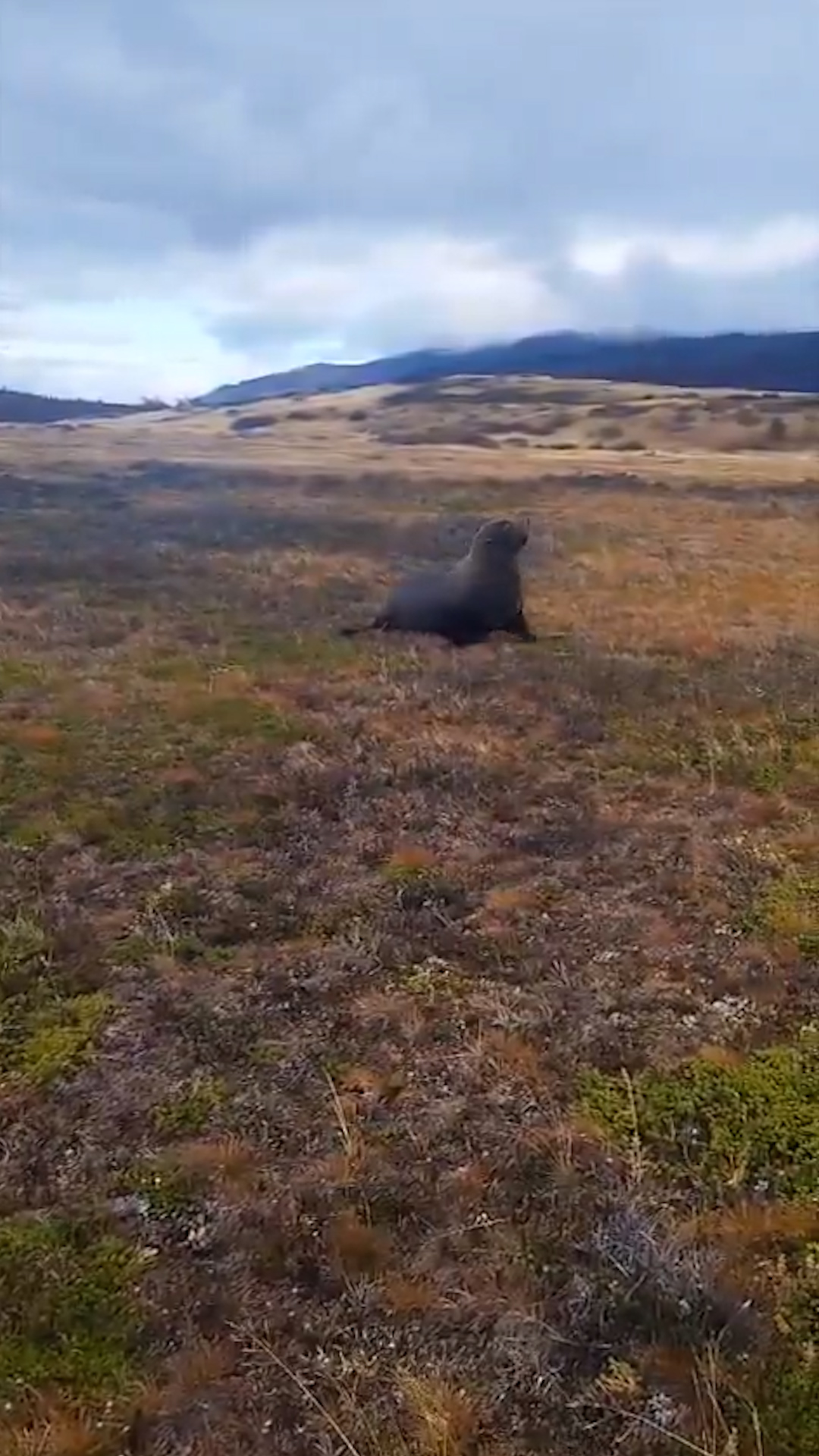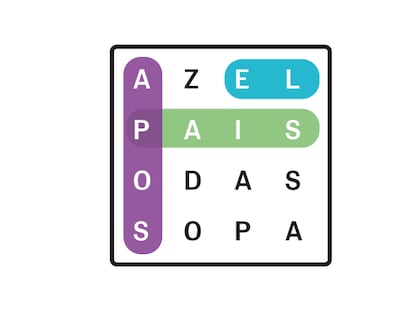The fur seal found in a Patagonian steppe, nearly 30 miles from the ocean
The sighting, the first of its kind recorded in Torres del Paine National Park, has revived questions about the impact of climate change on wildlife

The sun was rising over Torres del Paine National Park in Chilean Patagonia when a couple of tourists, accompanied by a park ranger, spotted something out of place in the landscape. It wasn’t a puma, nor a guanaco or condor — species commonly seen in the area.
On the Carretas Trail in the Pampa del Serrano, a low-vegetation plain less than a mile from the park’s administrative center, a Southern American fur seal (Arctophoca australis) was resting. Common along Chile’s southern coast, this species measures between 1.5 and 1.8 meters in length, has a long, upturned snout, and weighs between 198 and 264 pounds (90 and 120 kilograms). Yet here it was, nearly 30 miles (50 kilometers) from the nearest ocean.

It was mid-morning on Wednesday, May 7. The sighting — the first recorded instance of this species in Chile’s most iconic national park — set off a chain of responses. Park officials alerted Chile’s National Fisheries and Aquaculture Service, the agency legally responsible for the country’s marine fauna. Because the southern fur seal is a protected species in Chile, it cannot be captured or handled by anyone outside this authority.
Two hours later, a team from the agency arrived and confirmed it was a juvenile: light-colored fur along its back, active, with no visible injuries or signs of distress. Ximena Gallardo, the agency’s regional director and an attorney, described it as a lively animal that “kept its distance from people.” It was carefully transported in a metal cage to a beach in the Río Hollemberg area, about 16 miles (25 kilometers) from the city of Puerto Natales. Once released, the fur seal entered the sea and swam off with ease, disappearing into the water.
How did it get there?
While unusual, the sighting has a possible explanation. Mauricio Ruiz, regional director of the National Forest Corporation (CONAF) for Magallanes and Chilean Antarctica, believes the animal may have entered through the Señoret Channel in Puerto Natales, a fjord connected to the ocean.
This channel receives water from the Serrano River, which connects with the Grey River — one of the waterways flowing into the park. It is believed that this waterway allowed the animal to advance several miles inland. According to Ruiz, it may have sailed upstream following favorable currents and schools of salmonidae or other fish.
Thus, on the Carretas Trail, the fur seal wasn’t that far from the water. A few meters away, an active riverbed cuts through the vegetation. According to Gallardo, in regions like Tierra del Fuego, which have similar geography, similar cases have been documented: fur seals that swim upriver in search of food, rest briefly on land, and then return to the sea.
This isn’t unusual behavior. Fur seals, explains marine biologist Jorge Acevedo, a marine mammal specialist at the Center for Quaternary Studies of the Patagonian-Fire and Antarctica (CEQUA), feed and rest at sea, but also come ashore to sunbathe or dry off between swims.
While rare, Acevedo sees it as expected behavior: “The common fur seal also does this. It can go up rivers and even reach lakes further inland. And the same goes for the elephant seal,” he explains. “Plus, juvenile fur seals are more adventurous, more daring, more nomadic.”
Although, according to Acevedo, the South American fur seal was likely not lost and could probably have returned to the sea on its own after basking in the sun, the authorities decided to intervene to ensure its safety. The decision, Gallardo says, was a preventive one, given the risks of disorientation or land-based predation.
For CONAF, however, this incident cannot be dismissed as a mere anecdote. For Ruiz, it is a warning sign: something is changing in the park’s ecosystems, and it warrants closer attention. “There are indeed changes in behavior of fauna,” warns Ruiz. And while he emphasizes that many of these movements still follow natural patterns — “Wildlife moves where the food is: where there are more guanacos, pumas appear; where there are more hares, foxes show up” — he doesn’t rule out the role of climate change in altering routes and habits. “It’s not new: it’s here to change many wildlife behaviors.”
In a context of accelerating environmental change, encounters like this, so rare today, could become more common. For Ruiz, now is the time to prepare. That’s why, he says, when they update the management plan for Torres del Paine National Park, they will pay close attention to the new dynamics in the behavior of both flora and fauna.
Sign up for our weekly newsletter to get more English-language news coverage from EL PAÍS USA Edition
Tu suscripción se está usando en otro dispositivo
¿Quieres añadir otro usuario a tu suscripción?
Si continúas leyendo en este dispositivo, no se podrá leer en el otro.
FlechaTu suscripción se está usando en otro dispositivo y solo puedes acceder a EL PAÍS desde un dispositivo a la vez.
Si quieres compartir tu cuenta, cambia tu suscripción a la modalidad Premium, así podrás añadir otro usuario. Cada uno accederá con su propia cuenta de email, lo que os permitirá personalizar vuestra experiencia en EL PAÍS.
¿Tienes una suscripción de empresa? Accede aquí para contratar más cuentas.
En el caso de no saber quién está usando tu cuenta, te recomendamos cambiar tu contraseña aquí.
Si decides continuar compartiendo tu cuenta, este mensaje se mostrará en tu dispositivo y en el de la otra persona que está usando tu cuenta de forma indefinida, afectando a tu experiencia de lectura. Puedes consultar aquí los términos y condiciones de la suscripción digital.
More information
Archived In
Últimas noticias
Petro claims the ELN was the target of US attack in Venezuela
Maduro counterattacks Trump with rhetoric and announces downing of nine drug trafficking aircraft
‘Ecce Homo’: The miraculous disaster that made a small Spanish town famous
Return to sex testing at the Olympics: IOC edges closer to banning transgender women
Most viewed
- Sinaloa Cartel war is taking its toll on Los Chapitos
- Oona Chaplin: ‘I told James Cameron that I was living in a treehouse and starting a permaculture project with a friend’
- Reinhard Genzel, Nobel laureate in physics: ‘One-minute videos will never give you the truth’
- Why the price of coffee has skyrocketed: from Brazilian plantations to specialty coffee houses
- Silver prices are going crazy: This is what’s fueling the rally










































